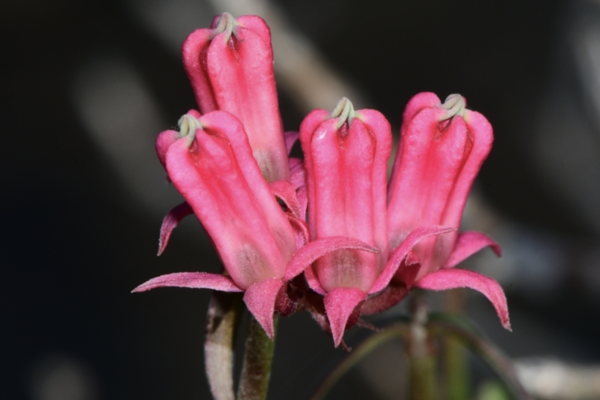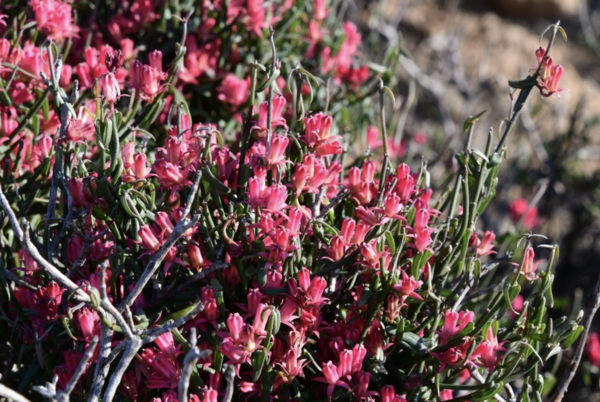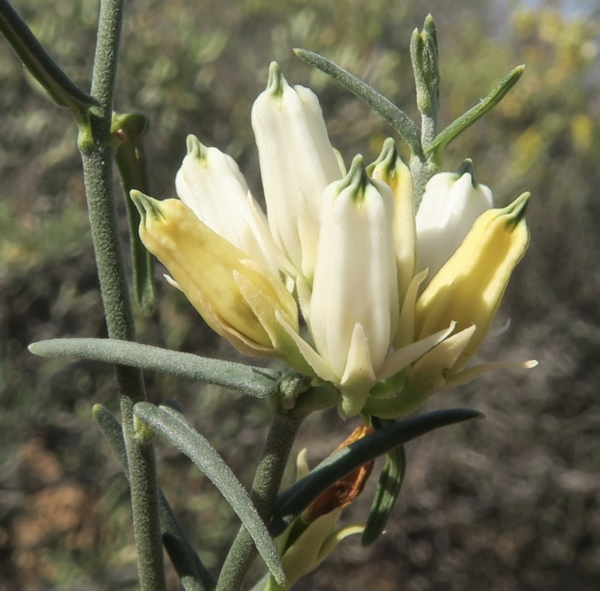Microloma sagittatum, commonly known as the Arrowleaf Lantern Flower, is a captivating and unique climbing plant native to the tropical regions of South America. With its distinct arrow-shaped leaves and delicate, lantern-like flowers, this plant is a favorite among gardeners and horticulturists alike. Its exotic appearance and fascinating growth habits make it a plant worth exploring for those interested in adding a touch of the unusual to their gardens or indoor spaces.

The Microloma sagittatum, also known as the Hairy-flowered Microloma, is an attractive, evergreen climber that features lance-shaped leaves, giving it a graceful yet robust appearance. These leaves are its most notable feature, boasting a distinctive arrowhead shape that is smooth-edged and deep green in color. The plant’s foliage has a soft texture, sometimes appearing slightly velvety due to its fine hairs, giving it an elegant touch.
What truly sets this plant apart, however, are its flowers. The blooms are small, funnel-shaped, and resemble delicate lanterns, hence the name “Arrowleaf Lantern Flower.” These flowers often come in shades of soft yellows and pale pinks, with darker patterns near the throat of the bloom. The flowers appear in clusters at the tips of the plant's vines, creating a charming and airy display that is sure to draw attention in any garden. The plant’s flowering period typically occurs in late spring to early summer, adding vibrant color to the landscape.
Native to tropical and subtropical regions of South America, Microloma sagittatum thrives in warm, humid environments. It is typically found in forests, forest edges, or along riverbanks where it can easily climb up trees or other plants. Its natural habitat is often characterized by high humidity, moderate rainfall, and moderate sunlight.
This plant is a climber by nature, and it can grow up to several meters long, seeking support from nearby structures, trees, or shrubs. In its natural habitat, it takes advantage of the dappled light available in the forest canopy, and thus, it does not tolerate full sun exposure but requires bright, indirect light for optimal growth.

Growing Microloma sagittatum outside its native environment can be a rewarding but somewhat challenging experience. It requires specific care to thrive and showcase its unique beauty. For gardeners interested in growing this exotic climber, here are some essential cultivation and care tips:
Light: While the plant prefers bright, indirect light, it is essential to avoid direct sunlight, especially in hot climates. Too much direct sun exposure can scorch its delicate leaves and flowers. If growing indoors, placing the plant near a window with filtered light or under a grow light would be ideal.
Temperature: As a tropical plant, Microloma sagittatum thrives in warm temperatures. The optimal growing temperature is between 18°C and 28°C (64°F to 82°F). This plant is not frost-tolerant, so it should be protected from cold weather. In colder climates, it is best to grow it as a houseplant or in a greenhouse where the temperature can be controlled.
Soil: The plant prefers well-draining, slightly acidic to neutral soil. A mix of loamy, organic soil with added perlite or sand to improve drainage is ideal. Overly compacted or poorly drained soils can lead to root rot, so ensuring good drainage is crucial.
Watering: Microloma sagittatum thrives in humid conditions and prefers consistently moist soil, but it should not be waterlogged. The soil should be kept evenly moist but not soggy. Water the plant when the top inch of soil feels dry, but always check that the water drains freely from the pot or ground to avoid root rot.
Humidity: Being a tropical plant, it thrives in high humidity. To mimic its natural habitat, you can mist the leaves regularly or place the plant in a humid environment, such as a bathroom with a window, or use a humidifier. If growing indoors, keeping the plant near other moisture-loving plants can also help.
Pruning and Support: As a climber, Microloma sagittatum will need support to grow properly. Provide a trellis, vine, or other structures for the plant to latch onto. Regular pruning is also beneficial to maintain the plant's shape and encourage bushier growth. Remove any dead or damaged stems to promote fresh growth.
The most enchanting feature of Microloma sagittatum is undoubtedly its unique flowers. These small, lantern-shaped blooms are typically around 1 to 2 inches long and come in shades of light yellow, pink, or occasionally white. The blossoms grow in clusters, hanging delicately from the plant’s vines, and their soft, bell-like structure gives them an ethereal, fairy-tale quality.
The flowers are not only beautiful but also attract pollinators like hummingbirds and bees, making them an important part of the local ecosystem. The blooms also produce a subtle, sweet fragrance that can fill the air around the plant, making it a delightful addition to any garden.

Although Microloma sagittatum is mostly admired for its ornamental value, some indigenous cultures have used plants from the Microloma genus for medicinal purposes. However, specific uses for Microloma sagittatum remain largely undocumented in modern herbal medicine. It is important to note that the plant’s primary appeal lies in its striking beauty rather than its practical applications.
In some regions, the plant's unique appearance has inspired local folklore and artistic representations. Its lantern-like flowers evoke images of mystical, glowing lights, and in some cultures, it is believed to bring luck and prosperity, particularly when placed in the home or garden.
The Arrowleaf Lantern Flower (Microloma sagittatum) is a remarkable plant that offers both aesthetic beauty and a touch of the mystical to any garden or indoor space. With its unique arrow-shaped leaves and lantern-like blooms, it brings a sense of magic and wonder wherever it is cultivated. Whether you're a seasoned gardener looking for a new challenge or someone looking to add a touch of the exotic to your home, Microloma sagittatum is a plant that is sure to captivate and inspire. Its low maintenance needs, combined with its striking appearance, make it a perfect addition to any tropical or temperate garden, or as a special houseplant.
animal tags: Microloma-sagittatum
We created this article in conjunction with AI technology, then made sure it was fact-checked and edited by a Animals Top editor.